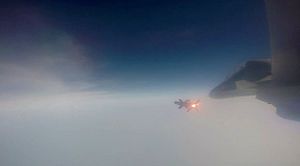The Indian Air Force (IAF) has successfully conducted a pre-induction trial of the indigenously designed and developed Astra beyond visual range air-to-air missile (BVRAAM) on September 26, according to a statement by Indian Ministry of Defense (MoD).
The missile was test fired from an IAF Sukhoi Su-30MKI multirole air superiority fighter from Kalaikunda Air Force Station in the Indian state of West Bengal, home to a Su-30MKI squadron. The test targeted an unmanned aerial vehicle, which the missile successfully destroyed.
“The missile successfully engaged a maneuvering target with high precision meeting the mission objectives,” the MoD statement reads. “In the series of trials held to date, Astra has been launched in the complete Su-30 flight envelope.” The final development flight trials of the missile against unmanned aerial targets were conducted in the fall of 2017.
According to the MoD, this week’s flight test “assumes significance as it was part of the series of final pre-induction trials. Astra is the best in class weapon system and has undergone more than twenty developmental trials.” The Astra has been under development by India’s Defense Research and Development Organization (DRDO) for over a decade.
With a speed of Mach 4.5, the missile’s maximum range when fired from an altitude of 15,000 meters is about 110 kilometers, which is reduced to about 44 kilometers when launched at an altitude of 8,000 meters. Fitted with a high-explosive pre-fragmented warhead, the missile uses an inertial guidance system with an active radar seeker with a homing range of 25 kilometers.
Limited serial production of the Astra BVRAAM began in 2017. DRDO is also currently working on an extended-range variant of the Astra. The Astra BVRAAM will be integrated with the IAF fleet of Su-30MKI, the mainstay of India’s fighter force. As I reported elsewhere:
The twin-seater, twin-engine Su-30MKI, developed by Russian aircraft maker Sukhoi and license-built in India, constitutes the backbone of the IAF. While the first 50 Su-30 aircraft were built in Russia, the remaining fighter jets were assembled in India. The IAF originally received the older Su-30MK variant from Russia, which the Indian defense industry in partnership with Russian defense companies upgraded to the MKI standard.
Unlike the Russian Su-30SM, the MKI version includes Israeli and French avionics. For example, the aircraft is fitted with a French-made heads-up display system, and an Israeli electronic warfare system and an advanced targeting pod. The Su-30MKI also features AL-37FP thrust-vectoring engines and canard foreplanes for increased maneuverability. HAL and Sukhoi are currently negotiating a contract for the upgrade of older Su-30MKI models in service with the IAF.
The IAF currently operates 272 Su-30MKIs. India is in talks with Russia over an additional 40 Su-30MKIs for the IAF. Negotiations are also under way to upgrade the existing fleet of Su-30MKIs to “Super Sukhois,” which includes upgrading the fighters with new long-range, precision-strike weapons systems, upgraded engines, and more advanced avionics.

































